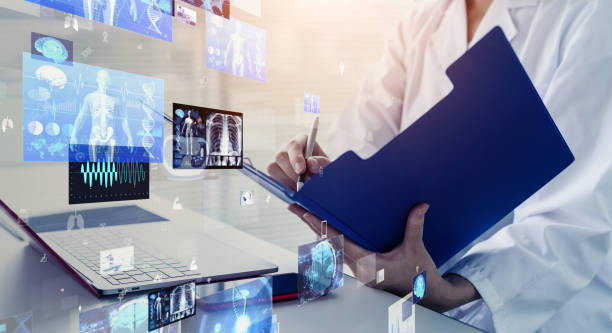
Stop.
Listen: the chart is learning to speak.
For years, medical records were quiet prisons of paper and passive pixels fragments of memory buried under clinician fatigue. Now, with natural language processing, EMRs have found a voice. They don’t just store our words anymore; they hear them, shape them, and hand them back as something that helps a human reach another human.
The First Breath: Transcription as Tenderness
Imagine a night-shift nurse voice tired, hands full, heart full. She leans close to a patient and speaks, not to a screen, but to a companion that listens. Her words flow: symptoms, family concerns, and a joke about the weather. The scribe transcribes with near human patience, organizes the note into clean sections, and highlights the one line a future clinician can’t miss: “Patient reports dizziness when standing.”
Suddenly, documentation is less of an interruption and more of an act of witness. Time returns to bedside.
Summaries That Sit Like a Friend
Doctors hate repeating histories. Families hate repeating traumas. NLP turns long clinic conversations into compassionate summaries in plain language paragraphs that a patient, a daughter, or a PCP can read in peace. No more medical shorthand that feels like exclusion; instead, a single-page story that preserves nuance, not just numbers.
An oncologist opens a chart and reads a one-paragraph “what matters” line: pain managed by evening meds, worried about grandchild’s graduation, prefers phone calls at 6 p.m. That line changes how care is given; it humanizes the algorithm.
The Quiet Alarms: Listening for What Is Unsaid
Beyond words, NLP listens for pattern and pulse. It spots phrases that hide danger. “I don’t sleep,” “I’ve been off meds,” “It’s been hard lately.” Sentiment analysis and risk-flagging algorithms surface subtle cries for help:a rising sadness in notes, a cluster of missed appointments, and descriptions that predict deterioration. In ER triage or behavioural health follow up, those whispers become life-saving nudges.
But this power asks for gentleness. Alerts must be precise, explanations must be clear, and humans must always hold the final hand.
From Free Text to Actionable Insight
Clinical notes are messy, emotional, and human. NLP turns that glorious mess into structured insight: problem lists are auto updated, medication changes are reconciled, and social determinants are pulled into care plans. Imagine a primary care visit where food insecurity is flagged automatically and the social worker’s number is already suggested in the after-visit summary. That is caring, anticipatory, and kind.
The Scribe That Learns Your Voice Not Replaces It
There’s fear in every tool that sounds like a cure: will machines replace us? The new reality is different. NLP amplifies human skill. It scribes the story; the clinician corrects the nuance. It drafts the discharge note; the team signs with a human line. When done right, technology is a mirror, not a mask, reflecting the clinician’s judgment back at them, clearer.
The Shadows We Must Name
This new voice is not without its dissonance. Language models can mishear accents, mistranslate idioms, and amplify biases buried in clinical text. Privacy sits on a knife’s edge: genomic terms or family secrets could be parsed and exposed if safeguards lag. And algorithmic suggestions, if presented without context, can nudge care toward protocol rather than personhood.
Safety is not an afterthought. It is the first requirement: clinician oversight, explainable models, robust consent, and audits that ensure the language of care remains humane and fair.
The Future, Speaking Plainly
Picture a world where a patient’s portal greets them with a short, gentle note after every visit about what was discussed, what to watch for, and one question to ask their next clinician. Picture interdisciplinary teams reading the same humanized summaries, where social history and genetic flags sit alongside vitals. Picture clinicians using voice to heal, not to log.
NLP gives EMRs a new dialect, one grounded in story and tuned for care. It asks us to listen differently: to the cadence of a nurse’s report, to the pauses in a patient’s sentence, to the patterns that hide in quiet language.
A Small Request, A Big Hope
If you build these systems, build them like translators of tenderness. If you use them, use them to give presence back to people. Teach the models, yes, but teach the humans too: how to read the summaries, how to question the flags, and how to keep responsibility where it belongs.
Language is our oldest technology. Now it becomes medicine again, not by erasing the human voice, but by making sure every voice is finally heard.
